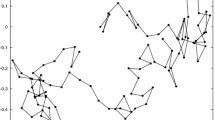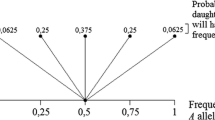Abstract
Whilst the rate at which mutations occur in artificial evolutionary systems has received considerable attention, there has been little analysis of the mutation operators themselves. Here attention is drawn to the possibility that inherent biases within such operators might arte-factually affect the direction of evolutionary change. Biases associated with several mutation operators are detailed and attempts to alleviate them are discussed. Natural evolution is then shown to be subject to analogous mutation “biases”. These tendencies are explicable in terms of (i) selection pressure for low mutation rates, and (ii) selection pressure to avoid parenting non-viable offspring. It is concluded that attempts to eradicate mutation biases from artificial evolutionary systems may lead to evolutionary dynamics that are more unnatural, rather than less. Only through increased awareness of the character of mutation biases, and analyses of our models’ sensitivity to them, can we guard against artefactual results.
Access this chapter
Tax calculation will be finalised at checkout
Purchases are for personal use only
Preview
Unable to display preview. Download preview PDF.
Similar content being viewed by others
References
Enquist, M., Arak, A.: Symmetry, beauty and evolution. Nature 372 (1994) 169–172
Bullock, S., Cliff, D.: The role of ‘hidden preferences’ in the artificial co-evolution of symmetrical signals. Proc. Roy. Soc. Lond., B 264 (1997) 505–511
Schaffer, J.D., ed.: Proceedings of the Third International Conference on Genetic Algorithms, Morgan Kauffman, San Mateo, CA (1989)
Bäck, T.: Self-adaptation in genetic algorithms. In Varela, F., Bourgine, P., eds.: Toward a Practice of Autonomous Systems, Cambridge, MA, MIT Press (1992) 263–271
Bäck, T.: Optimal mutation rates in genetic search. In Forest, S., ed.: Proceedings of the Fifth International Conference on Genetic Algorithms, San Mateo, CA, Morgan Kauffmann (1993) 2–8
Maley, C.: The coevolution of mutation rates. In Morán, F., Moreno, A., Merelo, J.J., Chacón, P., eds.: Advanced in Artificial Life, Berlin, Springer Verlag (1995) 219–233
Gray, F.: Pulse code communication. U.S. Patent 2 632 058 (1953)
Caruna, R.A., Schaffer, J.D.: Representation and hidden bias: Gray vs. binary coding for genetic algorithms. [3] 153–161
Press, W.H., Teukolsky, S.A., Vetterling, W.Y., Flannery, B.P.: Numerical recipes in C: The art of scientific computing. CUP, Cambridge (1992)
Leigh, E.G.: Natural selection and mutability. Am. Nat. 104 (1970) 301–35
Leigh, E.G.: The evolution of mutation rates. Genetics 73 (1973) 1–18
Taddel, F., Radman, M., Maynard Smith, J., Toupance, B., Gouyan, P.H., Godelle, B.: Role of imitator alleles in adaptive evolution. Nature 387 (1997) 700–702
Sniegowski, P.D., Gerrish, P.J., Lenski, R.E.: Evolution of high mutation rates in experimental populations of e. coli. Nature 387 (1997) 703–705
Dawkins, M.S., Guilford, T.: An exaggerated preference for simple neural network models of signal evolution? Proc. Roy. Soc. of Lond, B 261 (1995) 357–360
Author information
Authors and Affiliations
Editor information
Editors and Affiliations
Rights and permissions
Copyright information
© 1999 Springer-Verlag Berlin Heidelberg
About this paper
Cite this paper
Bullock, S. (1999). Are Artificial Mutation Biases Unnatural?. In: Floreano, D., Nicoud, JD., Mondada, F. (eds) Advances in Artificial Life. ECAL 1999. Lecture Notes in Computer Science(), vol 1674. Springer, Berlin, Heidelberg. https://doi.org/10.1007/3-540-48304-7_11
Download citation
DOI: https://doi.org/10.1007/3-540-48304-7_11
Publisher Name: Springer, Berlin, Heidelberg
Print ISBN: 978-3-540-66452-9
Online ISBN: 978-3-540-48304-5
eBook Packages: Springer Book Archive




